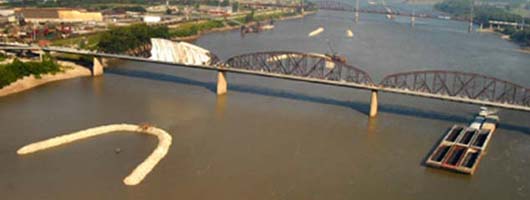
Mosenthien Project
Nearly 530 thousand tons of rock were placed in the Mississippi River in the St. Louis Harbor in order to improve navigation on a five mile stretch of river. The reach extends from the lower end of the Chain of Rocks Canal down to the Poplar Street Bridge.
The U.S. Army Corps of Engineers St. Louis District designed the project at its Applied River Engineering Center, located at its Service Base at the foot of Arsenal Street, and provided engineering during construction. The construction contractor was Patton-Tully Construction LLC (Memphis, Tenn.)
Three chevrons and dikes were built between Merchants and McKinley Bridges and one just south of McKinley Bridge. Constructed in the shape of a 'U', with the closed part facing upstream, the chevrons help direct river flows to improve the overall navigation channel.
The chevron construction was completed in conjunction with efforts to extend and raise the existing dike that projects south of the Chain of Rocks Canal opening at river mile 183.5. The extended dike creates a quiet water area south of the canal opening, providing better access conditions for barge traffic, and provides better alignment for barges traveling between the Merchants Bridge piers.
A third component of this $5.1 million project includes the construction of three Bendway Weirs between Poplar Street and Eads Bridges. The Bendway Weirs were constructed to improve navigation condition through the Polar Street Bridge. The St. Louis Harbor has been an area requiring repeated dredging by the Army Corps of Engineers to help maintain the required minimum depth of nine feet and channel width of 300 feet for safe and dependable navigation. Roughly $5.5 million was spent dredging this stretch of river between 1999 and 2005. It is estimated that the work will pay for itself in six years and then save an average of $925,000 annually in dredging costs.
An aerial view looking northward, up the Mississippi River in the St. Louis Harbor, shows three rock structures called chevrons, being built by the U.S. Army Corps of Engineers to modify the flow of the river to make navigation safer and more efficient while reducing or eliminating the need for costly dredging every year. The McKinley Bridge is in the foreground with the Merchants railroad bridge beyond it. Further north and to the right is the dike enhancing traffic into and out of the Chain of Rocks Canal, which is also being heightened and lengthened in the project. U.S. Army Corps of Engineers photo by Alan Dooley, Chief of Public Affairs, at 314-2331-8002. For technical project information contact Robert D. Davinroy, P.E., Chief, Applied River Engineering Center, at 314-263-4714.
